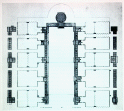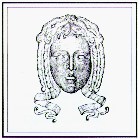 This is the second in a series of historic structure reports that are being prepared for the buildings of Thomas Jefferson's Academical Village. The first report, dealing with Pavilion I, was issued in 1988. This report on Pavilion VI was begun in 1989 and completed in 1990.
This is the second in a series of historic structure reports that are being prepared for the buildings of Thomas Jefferson's Academical Village. The first report, dealing with Pavilion I, was issued in 1988. This report on Pavilion VI was begun in 1989 and completed in 1990. Like the Pavilion I study, this report strongly recommends the adoption of a curatorial approach to the maintenance, renewal, and restoration of a significant historic building. Just as an art conservator would not intervene in the life of an artistic artifact before obtaining a thorough knowledge of its history, composition, and significance, so those engaged in the preservation of buildings and landscapes should proceed only from a basis of knowledge. Far too often in the past, the cultural integrity of buildings and their settings has been compromised by approaches to restoration that have been grounded on personal whim, willful romanticism, and expedient notions of repair or renewal.
The preparation of a historic structure report is the first step in adopting a disciplined approach to the care of a historic building. Over the course of the past year, a team comprised of architectural historians, archival researchers, architects, and building conservators was engaged in producing this report on Pavilion VI. The team's activities may be broadly described as surveying and recording. Surveying includes reconnaissance of archives and detailed investigations at the site. Recording entails setting down a permanent graphic and written record of these findings. Assembling the minutiae of the building's history and current conditions creates a benchmark that not only will provide a guide for immediate work but also will furnish future generations with a clear picture of what was found in our time.
With gleanings from Jefferson's papers, the university's architects, and other written accounts and graphic materials about the university, it has been possible to assemble a history of the building's design, construction, subsequent alteration, and use. Careful measurement of all exterior and interior features of the building has made possible the preparation for the first time of a comprehensive set of architectural drawings, which illustrate in plans, sections, elevations, and details, the existing configuration, as well as the evidence of original construction. At the same time, a detailed architectural description of the entire structure, including all exterior features and each interior space, was written. All constituent parts of the building's fabric were examined to determine the nature of physical problems that have occurred over the decades, the existing conditions, and the scope of needed repairs. A preliminary investigation of historic paint layers assisted in dating various elements and in understanding of the building's problems, current shortcomings, and long-range plans for its use.
This report was prepared for Pavilion VI because it is the next building where extensive restoration work is planned. Along with the report for Pavilion I, it is part of the ongoing program to prepare historic structure reports on all the physical aspects of the Jeffersonian Precinct before major construction work is undertaken. This program will provide a framework for knowledge and collective consensus to replace individual whim, uncertainty, and expediency in dealing with these important cultural resources.
By establishing the Jeffersonian Restoration Advisory Board and the position of Architect for the Historic Buildings and Grounds, the Board of Visitors of the university has recognized the need to assume responsible stewardship of the Academical Village. Over time, as the physical evidence of this approach becomes apparent, the university will have secured the gratitude of present and future generations for its sensitive and caring preservation of a national treasure.
 Table of Contents
Table of Contents